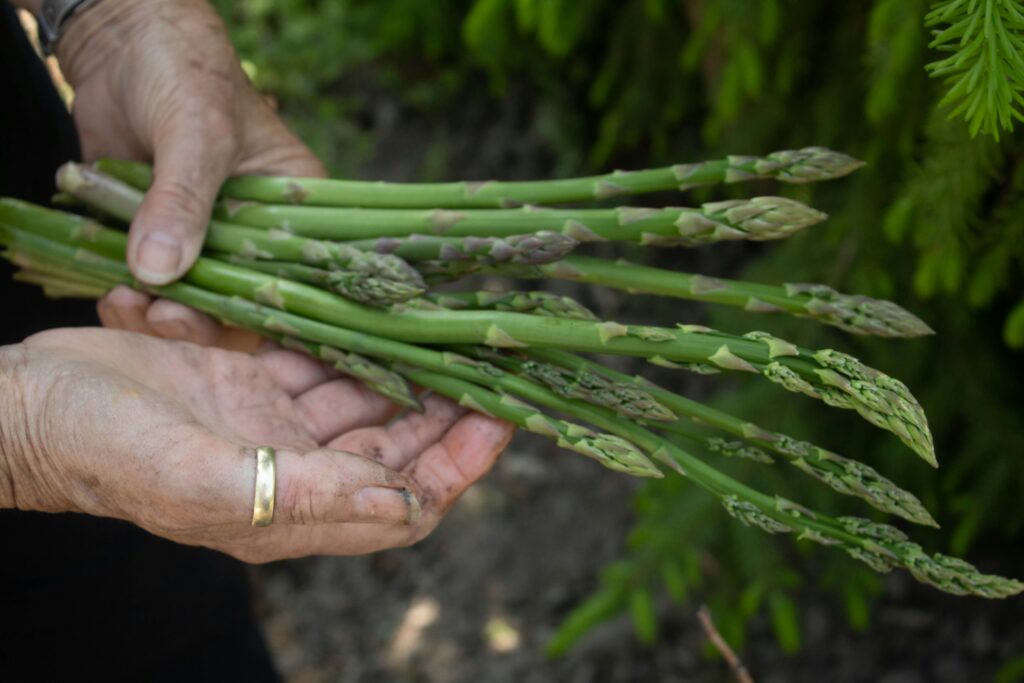
Asparagus, those vibrant green spears poking through the soil, are a true herald of spring. But beyond their delightful appearance, asparagus boasts a wealth of health benefits, a unique flavor profile, and a surprisingly long season for such a fleeting vegetable. Let’s delve into the world of asparagus and explore its delicious possibilities!
Benefits:
Asparagus is a powerhouse of nutrients! It’s a low-calorie source of fiber, vitamins A, C, K, and folate. It also contains essential minerals like potassium and iron. Studies suggest asparagus may aid digestion, promote heart health, and even offer anti-inflammatory properties.
Character:
Asparagus has a distinct flavor profile, often described as slightly grassy with a subtle sweetness. Its texture varies depending on the cooking method. Steamed or blanched asparagus retains a satisfying snap, while roasting brings out a deeper, nuttier flavor. Overcooked asparagus becomes mushy and a bit slimy in texture, so it’s better to err on the undercooked side. You can also eat asparagus raw, which adds a nice crisp texture to salads.
Asparagus contains a compound called asparagusic acid, which emits a sulfuric aroma when expelled through urination, but not everyone can smell it. If you are one of the population that can smell it – rest assured there is no reason for concern. It passes through your system in fairly short order.

Seasonality:
In many parts of the world, asparagus enjoys a short season, typically lasting from April to June. However, with a bit of searching, you might find it available earlier or later depending on your local climate and farming practices. Look for firm spears with tightly closed tips for the freshest quality. If the stalks are shriveled at all, or the tips are mushy, this means they are no longer fresh.

Recipes:
Now that you’re armed with this asparagus knowledge, let’s get cooking! The first thing to know is, regardless of how you prepare it, you should either trim or snap off the ends of each spear – this is to ensure you are eating the tender part of the asparagus and not the woody or super fibrous part of the spear, which can be unpleasant in the mouth. Here are three diverse recipes to showcase the versatility of this spring superstar:
1. Lemon-Herb Roasted Asparagus:
This simple recipe allows the natural flavor of asparagus to shine. Toss asparagus spears with olive oil, salt, pepper, and your favorite fresh herbs (think rosemary, thyme, or oregano). Roast at 400°F (200°C) for 10-15 minutes, or until tender-crisp. Drizzle with fresh lemon juice, shaved parmesan cheese and fresh ground black pepper before serving. Yummm!
2. Asparagus & Goat Cheese Frittata:
This impressive brunch dish is surprisingly easy to make. Whisk together eggs, milk, grated parmesan cheese, and chopped fresh herbs. Layer asparagus spears and crumbled goat cheese in a skillet. Pour the egg mixture over the top and cook on low heat on the stovetop and then finish under the broiler for a golden brown top.
3. Creamy Asparagus Soup:
This silky smooth soup is perfect for a light and satisfying meal. Sauté chopped onion and garlic in olive oil. Add chopped asparagus stalks and cook until tender. Pour in vegetable broth and simmer. Purée the soup with a hand blender or in a food processor. Stir in cream cheese or heavy cream for a richer texture. Season with salt, pepper, and a touch of lemon juice. Garnish with crumbled bacon or chopped chives for an extra touch.
With its health benefits, delightful flavor, and versatility in the kitchen, asparagus is a true spring treasure. So, head down to your local farmers market and embrace this seasonal delight!

